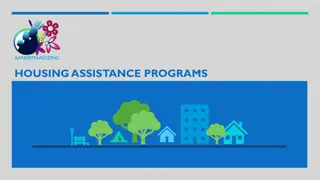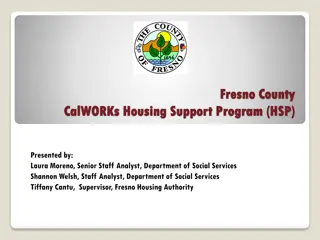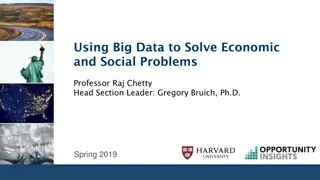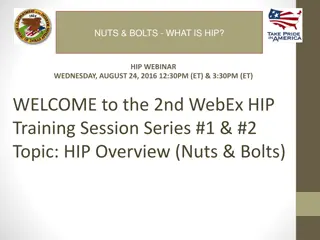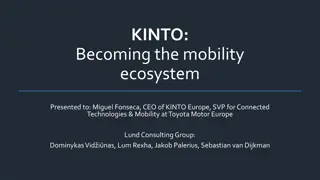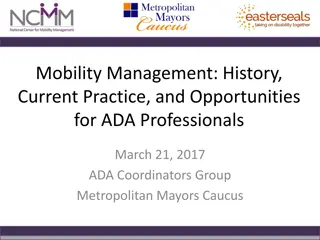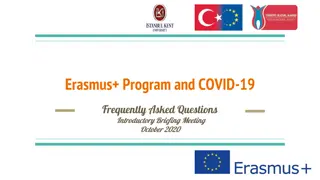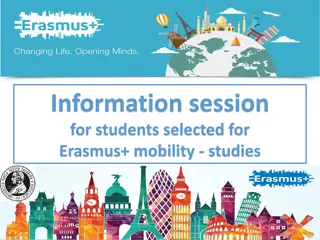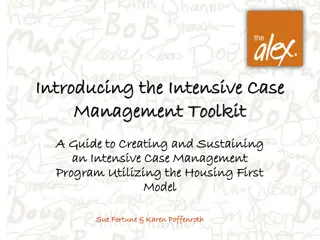Optimizing Re-Entry Success Through Mobility, Housing, and Services
Addressing the challenges of re-entry post-incarceration by focusing on key needs such as housing, employment, health services, support systems, and transportation. The project aims to identify optimal housing and service provider locations for individuals returning to Dallas, Texas, from incarceration, using a mixed methods approach including qualitative and quantitative strategies.
Download Presentation

Please find below an Image/Link to download the presentation.
The content on the website is provided AS IS for your information and personal use only. It may not be sold, licensed, or shared on other websites without obtaining consent from the author. Download presentation by click this link. If you encounter any issues during the download, it is possible that the publisher has removed the file from their server.
E N D
Presentation Transcript
Optimizing Mobility, Housing, and Services for Re-Entry Success Michael Mitchell, Department of Criminology and Criminal Justice Jaya Davis, Department of Criminology and Criminal Justice Anne Nordberg, School of Social Work Sarah Robinson, School of Social Work Craig Keaton, School of Social Work
The Problem Re-entry More than 600,000 individuals return to communities from prisons each year People cycle through jails more than 10.5 million times annually Recidivism 83% re-arrest within 9 years 55% re-incarceration within 5 years (BJS, 2018; NIJ, 2014; Sawyer & Wagner, 2019)
Most Commonly Identified Needs for Successful Reentry Housing Employment Access to health/mental health services Support system Meeting parole/probation obligations Transportation (La Vigne, Davies, Palmer, & Halberstadt, 2008; Morani, Wikoff, Linhorst, & Bratton, 2011)
The Project National Institute for Transportation and Communities (NITC) Objectives Given existing transportation networks, reentry obligations, and service provider locations; identify optimal housing locations (existing or proposed) for individuals returning to Dallas, Texas from incarceration. Given existing residential clusters of individuals returning from incarceration, transportation networks, and reentry obligations; identify optimal service provider locations (existing or proposed). Given existing residential clusters of individuals returning from incarceration, service provider locations, and reentry obligations; identify optimal residential assignments both overall and for individual clients.
The Project QIMS Mixed methods Informing the facility location problem (qualitative) Clients/Returning from incarceration Brokers TAC/CAB Facility location problem structure to formulate a strategy (quantitative) Siting housing for inmates reentering society Select optimal locations for social and health services Select the optimal location to house a single client
Qualitative Interpretive Meta-Synthesis (QIMS) Synthesizes published qualitative data to come to a deeper understanding of a phenomenon Environmental influences on services and the mental health for incarcerated populations (Terry, Praetorius, & Nordberg, 2018) Lived experiences of life without parole (Silva, 2015) Units of Study (n=11) Analysis using cloud based software
Author and publication year Bohmert (2016) Title Qualitative data collection method Age range, race and gender Recruitment city, state, year The role of transportation disadvantage for women on community supervision Interviews unreported, female Michigan, unreported Chavira, Botello, and Lagomasino (2016) Garland, Wodahl, and Mayfield (2011) Johnson (2014a) From prison to the community: The ab109 experience in los angeles county Interviews 28-56, African- American, Latino, & Caucasian, male Los Angeles County, California, unreported Prisoner reentry in a small metropolitan community: obstacles and policy recommendations Economic impediments to women s success on parole: We need someone on our side Women parolees perceptions of parole experiences and parole officers An exploration of community reentry needs and services for prisoners: A focus on care to limit return to high-risk behavior The reentry labyrinth: The anatomy of a reentry services network Just like baking a cake : Women describe the necessary ingredients for successful reentry after incarceration Interviews Avg. age 36, 70% white, male Springfield, Missouri area, 2008 Interviews 24-68, African- American & Caucasian, female unreported, 2009 Johnson (2014b) Interviews 24-68, African- American & Caucasian, female Unreported, African- American & Caucasian, male & female unreported, 2009 Luther, Reichert, Holloway, Roth, and Aalsma (2011) Nhan, Bowen, and Polzer (2017) O Brien (2001) Focus groups Indianapolis, Indiana area, 2010 Interviews Unreported, male & female Tarrant County, Texas, unreported Interviews 20-67, African- American, Hispanic, Korean/African- American (biracial), Native American, and Caucasian, female Unreported, African- American, Hispanic, and other non-whites, female 21-39, African- American, Hispanic, Caucasian, male & female Unreported, female unreported, 1996 Richie (2001) Challenges incarcerated women face as they return to their communities: Findings from life history interviews Beyond responsivity: Client service engagement in a reentry demonstration program Logistical barriers faced by women on parole: A critical ethnography Interviews unreported Sachs and Miller (2018) Interviews unreported Whittemore (2008) Ethnography unreported
Most common codes from QIMS 1. Public transportation takes lots of time 2. Transportation creates challenges for parole requirements 3. Lack of financial means for transportation 4. No transportation upon release/Immediate transportation issue 5. Not safe to walk
Major Themes 1) Obligations linked to transportation; 2) Challenges of public transportation, and; 3) Losses due to inadequate transportation.
Informing the Facility Location Problem Semi-structured interviews Clients Brokers* TAC/CAB
Initial Findings from Broker Interviews Dynamic nature of prioritization of client needs Client Strengths support structure, education, veteran status Deficits homelessness Broker Mentor vs facilitator Sustainable transportation Time 30-40 min Weather Modes of transport Independence
References BJS (2018) https://www.bjs.gov/index.cfm?ty=pbdetail&iid=6267 La Vigne, N., Davies, E., Palmer, T., & Halberstadt, R. (2008). Release planning for successful reentry: A guide for corrections, service providers, and community groups. Urban Institute: Justice Policy Center. https://www.urban.org/sites/default/files/publication/32056/411767- Release-Planning- for-Successful-Reentry.PDF NIJ (2014) https://www.bjs.gov/content/pub/pdf/rprts05p0510.pdf Sawyer, W., & Wagner, P. (2019). Mass incarceration: The whole pie 2019. Prison Policy Initiative: https://www.prisonpolicy.org/reports/pie2019.html Silva, S.M. (2015). On the meaning of life: A qualitative interpretive meta-synthesis of the lived experience of life without parole. Journal of Social Work, 15(5), 498-515. doi: 10.1177/1468017314550748. Terry, L.F., Praetorius, R.T., & Nordberg, A. (2018). Environmental influences on services for and mental health of incarcerated populations: A review. Journal of Social Work, 18(1), 46-65. doi: 10.1177/1468017316651999.



